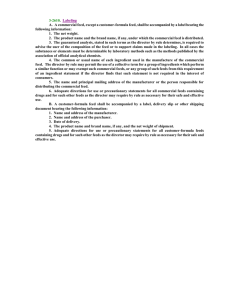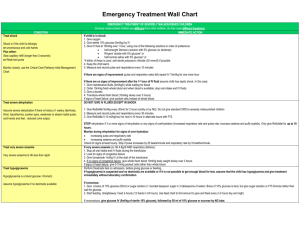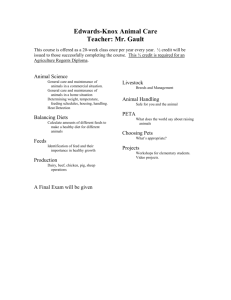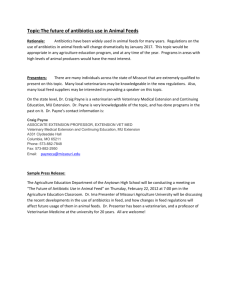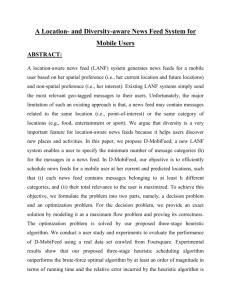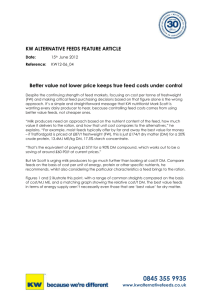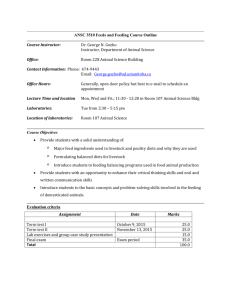`10 steps` wall chart for inpatient management
advertisement
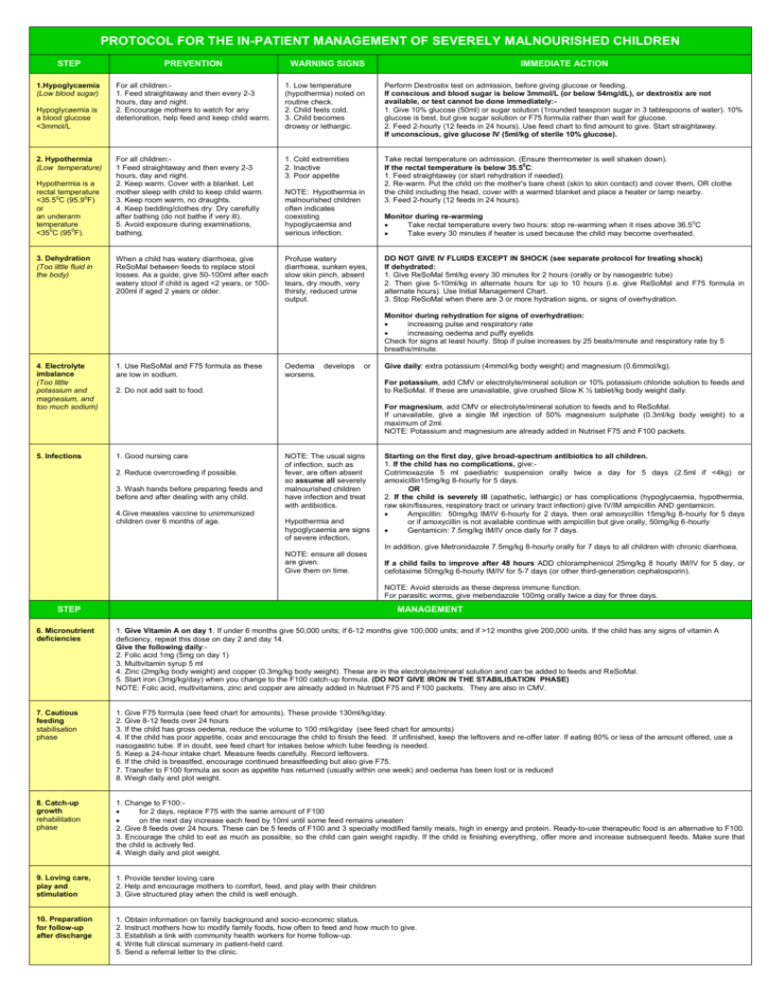
PROTOCOL FOR THE IN-PATIENT MANAGEMENT OF SEVERELY MALNOURISHED CHILDREN STEP PREVENTION 1.Hypoglycaemia (Low blood sugar) For all children:1. Feed straightaway and then every 2-3 hours, day and night. 2. Encourage mothers to watch for any deterioration, help feed and keep child warm. 1. Low temperature (hypothermia) noted on routine check. 2. Child feels cold. 3. Child becomes drowsy or lethargic. Perform Dextrostix test on admission, before giving glucose or feeding. If conscious and blood sugar is below 3mmol/L (or below 54mg/dL), or dextrostix are not available, or test cannot be done immediately:1. Give 10% glucose (50ml) or sugar solution (1rounded teaspoon sugar in 3 tablespoons of water). 10% glucose is best, but give sugar solution or F75 formula rather than wait for glucose. 2. Feed 2-hourly (12 feeds in 24 hours). Use feed chart to find amount to give. Start straightaway. If unconscious, give glucose IV (5ml/kg of sterile 10% glucose). For all children:1 Feed straightaway and then every 2-3 hours, day and night. 2. Keep warm. Cover with a blanket. Let mother sleep with child to keep child warm. 3. Keep room warm, no draughts. 4. Keep bedding/clothes dry. Dry carefully after bathing (do not bathe if very ill). 5. Avoid exposure during examinations, bathing. 1. Cold extremities 2. Inactive 3. Poor appetite Take rectal temperature on admission. (Ensure thermometer is well shaken down). If the rectal temperature is below 35.50C: 1. Feed straightaway (or start rehydration if needed). 2. Re-warm. Put the child on the mother's bare chest (skin to skin contact) and cover them, OR clothe the child including the head, cover with a warmed blanket and place a heater or lamp nearby. 3. Feed 2-hourly (12 feeds in 24 hours). When a child has watery diarrhoea, give ReSoMal between feeds to replace stool losses. As a guide, give 50-100ml after each watery stool if child is aged <2 years, or 100200ml if aged 2 years or older. Profuse watery diarrhoea, sunken eyes, slow skin pinch, absent tears, dry mouth, very thirsty, reduced urine output. Hypoglycaemia is a blood glucose <3mmol/L 2. Hypothermia (Low temperature) Hypothermia is a rectal temperature <35.50C (95.90F) or an underarm temperature <350C (950F). 3. Dehydration (Too little fluid in the body) WARNING SIGNS NOTE: Hypothermia in malnourished children often indicates coexisting hypoglycaemia and serious infection. IMMEDIATE ACTION Monitor during re-warming Take rectal temperature every two hours: stop re-warming when it rises above 36.50C Take every 30 minutes if heater is used because the child may become overheated. DO NOT GIVE IV FLUIDS EXCEPT IN SHOCK (see separate protocol for treating shock) If dehydrated: 1. Give ReSoMal 5ml/kg every 30 minutes for 2 hours (orally or by nasogastric tube) 2. Then give 5-10ml/kg in alternate hours for up to 10 hours (i.e. give ReSoMal and F75 formula in alternate hours). Use Initial Management Chart. 3. Stop ReSoMal when there are 3 or more hydration signs, or signs of overhydration. Monitor during rehydration for signs of overhydration: increasing pulse and respiratory rate increasing oedema and puffy eyelids Check for signs at least hourly. Stop if pulse increases by 25 beats/minute and respiratory rate by 5 breaths/minute. 4. Electrolyte imbalance (Too little potassium and magnesium, and too much sodium) 1. Use ReSoMal and F75 formula as these are low in sodium. 5. Infections 1. Good nursing care Oedema develops worsens. or Give daily: extra potassium (4mmol/kg body weight) and magnesium (0.6mmol/kg). For potassium, add CMV or electrolyte/mineral solution or 10% potassium chloride solution to feeds and to ReSoMal. If these are unavailable, give crushed Slow K ½ tablet/kg body weight daily. 2. Do not add salt to food. For magnesium, add CMV or electrolyte/mineral solution to feeds and to ReSoMal. If unavailable, give a single IM injection of 50% magnesium sulphate (0.3ml/kg body weight) to a maximum of 2ml. NOTE: Potassium and magnesium are already added in Nutriset F75 and F100 packets. 2. Reduce overcrowding if possible. 3. Wash hands before preparing feeds and before and after dealing with any child. 4.Give measles vaccine to unimmunized children over 6 months of age. NOTE: The usual signs of infection, such as fever, are often absent so assume all severely malnourished children have infection and treat with antibiotics. Hypothermia and hypoglycaemia are signs of severe infection. Starting on the first day, give broad-spectrum antibiotics to all children. 1. If the child has no complications, give:Cotrimoxazole 5 ml paediatric suspension orally twice a day for 5 days (2.5ml if <4kg) or amoxicillin15mg/kg 8-hourly for 5 days. OR 2. If the child is severely ill (apathetic, lethargic) or has complications (hypoglycaemia, hypothermia, raw skin/fissures, respiratory tract or urinary tract infection) give IV/IM ampicillin AND gentamicin. Ampicillin: 50mg/kg IM/IV 6-hourly for 2 days, then oral amoxycillin 15mg/kg 8-hourly for 5 days or if amoxycillin is not available continue with ampicillin but give orally, 50mg/kg 6-hourly Gentamicin: 7.5mg/kg IM/IV once daily for 7 days. In addition, give Metronidazole 7.5mg/kg 8-hourly orally for 7 days to all children with chronic diarrhoea. NOTE: ensure all doses are given. Give them on time. If a child fails to improve after 48 hours ADD chloramphenicol 25mg/kg 8 hourly IM/IV for 5 day, or cefotaxime 50mg/kg 6-hourly IM/IV for 5-7 days (or other third-generation cephalosporin). NOTE: Avoid steroids as these depress immune function. For parasitic worms, give mebendazole 100mg orally twice a day for three days. STEP MANAGEMENT 6. Micronutrient deficiencies 1. Give Vitamin A on day 1. If under 6 months give 50,000 units; if 6-12 months give 100,000 units; and if >12 months give 200,000 units. If the child has any signs of vitamin A deficiency, repeat this dose on day 2 and day 14. Give the following daily:2. Folic acid 1mg (5mg on day 1) 3. Multivitamin syrup 5 ml 4. Zinc (2mg/kg body weight) and copper (0.3mg/kg body weight). These are in the electrolyte/mineral solution and can be added to feeds and ReSoMal. 5. Start iron (3mg/kg/day) when you change to the F100 catch-up formula. (DO NOT GIVE IRON IN THE STABILISATION PHASE) NOTE: Folic acid, multivitamins, zinc and copper are already added in Nutriset F75 and F100 packets. They are also in CMV. 7. Cautious feeding stabilisation phase 1. Give F75 formula (see feed chart for amounts). These provide 130ml/kg/day. 2. Give 8-12 feeds over 24 hours 3. If the child has gross oedema, reduce the volume to 100 ml/kg/day (see feed chart for amounts) 4. If the child has poor appetite, coax and encourage the child to finish the feed. If unfinished, keep the leftovers and re-offer later. If eating 80% or less of the amount offered, use a nasogastric tube. If in doubt, see feed chart for intakes below which tube feeding is needed. 5. Keep a 24-hour intake chart. Measure feeds carefully. Record leftovers. 6. If the child is breastfed, encourage continued breastfeeding but also give F75. 7. Transfer to F100 formula as soon as appetite has returned (usually within one week) and oedema has been lost or is reduced 8. Weigh daily and plot weight. 8. Catch-up growth rehabilitation phase 1. Change to F100: for 2 days, replace F75 with the same amount of F100 on the next day increase each feed by 10ml until some feed remains uneaten 2. Give 8 feeds over 24 hours. These can be 5 feeds of F100 and 3 specially modified family meals, high in energy and protein. Ready-to-use therapeutic food is an alternative to F100. 3. Encourage the child to eat as much as possible, so the child can gain weight rapidly. If the child is finishing everything, offer more and increase subsequent feeds. Make sure that the child is actively fed. 4. Weigh daily and plot weight. 9. Loving care, play and stimulation 1. Provide tender loving care 2. Help and encourage mothers to comfort, feed, and play with their children 3. Give structured play when the child is well enough. 10. Preparation for follow-up after discharge 1. Obtain information on family background and socio-economic status. 2. Instruct mothers how to modify family foods, how often to feed and how much to give. 3. Establish a link with community health workers for home follow-up. 4. Write full clinical summary in patient-held card. 5. Send a referral letter to the clinic.
